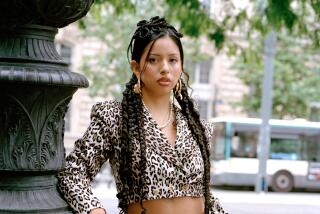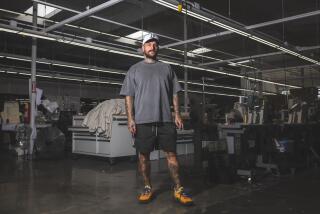Shoeshine man with bounce in his step gains a foothold at Union Station

Marco Ramirez polishes a pair of shoes for a customer at his shoeshine stand at Union Station
Marco Ramirez could not be more proud of his new shoeshine stand at Union Station.
It was specially built out of wood to echo the waiting room’s Art Deco armchairs.
The brass footrests gleam. Ramirez beams. He stretches his arms wide.
With these four high-perched seats, he brings the art of the shoeshine back to the historic station for the first time in decades — and expands his empire across the heart of downtown.
Thwap, thwap, thwap. He snaps his cloth across a businessman’s black brogues as his own Salvatore Ferragamo loafers, bought used at a swap meet, glide and tap out a rhythm on the vintage tile.
He sees his work as performance art, as craft, even as a form of therapy. Sit for a while, rest, be pampered, leave with a bounce in your step.
His stand is at the west end of the long passageway through which more than 60,000 people travel daily to and from trains and buses.
As he tends to a steady stream of shoes and boots, he thanks those he credits with putting him in “the hub of Los Angeles.”
“I’m really blessed that they chose me to run this operation,” he says.
He thanks God. He thanks the leaders of the Los Angeles County Metropolitan Transportation Authority. He thanks the people who manage the station.
He also thanks the members of the Los Angeles Athletic Club, where he has worked since he was 20 years old.
In 31 years of conditioning Italian leather and buffing the scuffs off tassel loafers in the club’s men’s locker room, he has come to count among his friends millionaires and billionaires. Businessmen, doctors, lawyers, real estate brokers, he says, have shared their most private thoughts and opened this and other doors for him.
They also have taught him all he knows about business — about having a strong work ethic, about old-fashioned courtesy, about forging friendships that last.
Until recently Ramirez, who works five days a week at the club, also ran a stand at the U.S. Bank Tower. But a lobby renovation shut him down, so he’d been trying to make up the lost income on the weekends by working at a recycling center.
Then came the chance to open at Union Station.
Father of three, grandfather of seven, Ramirez works hard and may never be rich. But, he says, “I am too blessed to be stressed.”
He was born in Tuxpan, in the Mexican state of Nayarit. When he came to L.A. at age 10, he and his mother, brother and stepfather lived in rooms on skid row. His mother found work on a line processing shrimp at a fishery, his stepfather on a demolition crew.
Eventually they made their way to Boyle Heights, where Ramirez says he started running wild. At 17, after just one year at Roosevelt High, he signed up for the U.S. Army and finished school while working as a field artillery soldier on bases in Germany and Louisiana.
When he got back home, the unemployment office sent him to the Athletic Club to fill in for the regular shoeshine.
From his military service, he knew how to shine a shoe. He’d also done it to earn change as a boy — on Brooklyn Avenue in Boyle Heights, around Olvera Street downtown.
Back then, he says, a standard shine was 50 cents. Now it’s $6 at the club and at the station, where he has enlisted another shoeshine, Filemon Ruano, to work with him.
All day long, Ramirez shuttles between club and station on the Red Line, often leaving the Boyle Heights duplex he owns before 4:30 a.m. to get in an L.A. Marathon training run with a club member. (This next marathon will be Ramirez’s eighth.)
By 6 a.m., he’s in the club locker room for the morning rush. By 9:30, he’s at Union Station. From noon to 2 p.m., he’s back at the club for the lunch crowd. He spends the rest of the afternoon at the station, though he tries to pop home if he can for a late lunch cooked by his wife, Lola. (The other day, it was sopa de fideo with two chicken and two potato taquitos.) Then it’s back to the club for the evening rush, from 5 to 8 p.m.
On his trips between jobs, he finds time to greet friends. At a barbershop in the Biltmore building, where he gets free haircuts. At the jewelry supply store off Pershing Square owned by his best friend, Sehak Tuna, a club member. On the sidewalk as he lugs a large bag full of shoes to drop off at a repair shop that does work for him at a discount. People call out his name from car windows and from across busy streets.
Ramirez stops to talk to each of them, asking about their jobs and their families, often leaving them with a line like, “It’s a good day so far.”
Being known matters to him. It’s important to make connections.
Since the Union Station stand opened last month, he’s gotten to know Amtrak workers, Starbucks baristas, daily commuters, Wetzel’s Pretzels cashiers.
He likes to position himself well in front of his chairs as the crowd swirls past, greeting strangers he hopes might become customers. “How are you doing, mija?” he says as he waves to a young woman. When a young man stops to snap a cellphone photo of the stand, he extends a hand. “My name is Marco and I am the shoe-ologist here.”
At 5 feet 7, he always stands tall. He says he’s “growing a day at a time.”
If someone tells him he’s the best, he shakes his head. Not yet. “With me, there’s more to come,” he says.
Asked how many shoes he needs to shine to have a good day, he answers: “Enough. He doesn’t always give me enough to pay my bills, but he gives me enough,” he says. “If I complain, God’s going to punish me and take it all away.”
A man in jeans and a windbreaker climbs onto a chair. His sensible brown walking shoes are so dull, they’re almost colorless in places. Ramirez approaches them with loving care. He gently brushes off dirt and dust. With a cloth wrapped around two fingers, he rubs in conditioning cream. In the next 10 minutes, he waxes, buffs and polishes until the old shoes look like new.
“I might have to dance,” the man says as he steps down from on high with shoes so shiny they reflect the overhead lights.
In the big wide world, Ramirez’s job shining shoes may seem small.
But that’s not the way he sees it. Not at all.
Follow City Beat @latimescitybeat on Twitter and at Los Angeles Times City Beat on Facebook.
More to Read
Sign up for Essential California
The most important California stories and recommendations in your inbox every morning.
You may occasionally receive promotional content from the Los Angeles Times.











